Your feedback is important to us
Please provide any feedback you have. Thank you!
Thank you!
Your feedback has been submitted.
 California Assessment of Student Performance and Progress
California Assessment of Student Performance and Progress
Please provide any feedback you have. Thank you!
Your feedback has been submitted.

See what skills are tested, understand your child's scores, and get ideas for how you can help at home.
Third graders should be reading all kinds of material, from folktales and myths — think Johnny Appleseed and Pandora’s Box — to articles and textbooks. They should be able to understand increasingly challenging text as well. At this age, Charlotte’s Web is an example of a grade-level text because the book gives kids the opportunity to think about the meaning behind the story and uses challenging vocabulary words like salutations and objectionable.
In both fiction and nonfiction, students need to identify key ideas and draw conclusions about what they’ve read, pointing to examples (also called evidence) to support their reasoning.
As they read, third graders should use context to figure out new words. For example, students can use context to understand that additional means more in this sentence: She had to work a few additional hours to get everything done.
Watch how a teacher gets a third grader to explain what she’s learning as she reads.

In college and at work, people spend much more time reading informational text than fiction. That’s why kids are asked to read informational text as well as stories. Examples of informational texts include nonfiction books, magazines, and newspaper articles.
Third graders are expected to give evidence, or reasons, for their thinking. For example, if a child concludes, “the stepmother in the story was mean,” that must be backed by proof. What shows that she was mean? “She made the girl clean up after everyone all by herself,” and “She laughed at her because she was dirty” are two examples of evidence from the story. Students should also be able to explain why the character might be acting a particular way. “The stepmother acted that way because she knew the man loved his daughter more than he loved her, his wife.”
In addition to stories, remember to read nonfiction texts. Pick something your child likes: maybe she’s interested in animals or other countries. If a book or article is hard for your child to read, it’s perfectly fine to read to her. If it’s not too hard, ask her to read to you or take turns reading aloud.
Here are some questions to get your child thinking. (Remember to ask Why? and How do you know?)
New words can get in the way of your child’s understanding. If your child pauses or stumbles on a word, she may not know its meaning. When your child comes across a word she doesn’t know, try this:
These 10 lessons at BeaLearningHero.org will give your child some practical experience reading in a variety of subjects, finding evidence, determining the main ideas, and using clues in the text to improve her skills.
Watch how a teacher guides a third grader through the process of figuring out a new word.

It’s important for third graders to build their academic vocabulary. These are words that are used often, in many subjects, but can be hard to define. Words such as additional, cause, examine, similar, and occur are examples of academic vocabulary. Check out this list for more academic vocabulary words to use with your third grader.
To help your third grader learn these words, try introducing one new word every day. Tell your child the meaning and another word or phrase that means the same thing. For instance, examine means the same as to look at closely or inspect. Next, make up a sentence using the word. I examine the roof to make sure there are no leaks. Ask her to come up with her own sentence. For fun, help your child keep a daily word journal. In a notebook, write down the new word, its meaning, and a creative sentence using it. The more fun the sentence, the better!
To be a strong reader, your child needs a combination of many skills: fluency, decoding, reading with expression, and comprehension. Kids also need to be steadily growing their knowledge about the world with every new poem, article, and text they read. Ask your child’s teacher which reading skills your child needs to work on. The teacher will help you understand your child’s reading strengths and areas to work on and also recommend books and articles that you and your child can read together.
At this age, kids should be writing clearly and including quite a few details.
Third graders are expected to think about why they are writing. Are they trying to tell a story (also called narrative writing)? Do they want to teach others about a topic (also called informational writing)? Do they want to convince someone of something (also called persuasive writing)? What they write will depend on the purpose of their writing.
See what teachers are looking for in your third grader’s writing.

No matter what your child writes about, he needs to focus on a main idea and connect each paragraph back to that idea. Third graders organize their informational or opinion writing into an introduction, a few full paragraphs, and a conclusion. Each paragraph should be focused on a single idea that ties into the main idea.
See what organized writing looks like in third grade.

Third graders’ punctuation, capitalization, and spelling skills should be improving, but you may still see errors in their work, such as forgetting to capitalize a name or misspelling common but difficult words, like caught or piece.
The writing test asks students to fix grammatical and spelling mistakes in sample writings as well as write and revise their own piece. Before they begin the longer writing part of the test, teachers lead a discussion with the kids about what they already know about a topic. Next, the students read some articles. Then they write. Students all write about the same subject, but they are randomly given a prompt to write a story (narrative writing), a report (informational writing), or a persuasive piece (persuasive writing).
Writing should be fun! To support your child’s writing, celebrate the ideas and minimize attention to punctuation, spelling errors, and imperfect handwriting. It’s all about sharing thoughts and finding your child’s voice.
Use these eight tools at BeaLearningHero.org to understand what’s expected of a third grader when the test talks about informative/explanatory, argumentative, or narrative writing.
Can you tell what’s missing in your child’s writing? Ask the teacher! Bring in a couple of your child’s writing samples (or ask your child’s teacher for samples) and ask the teacher to point out what’s working and where your child’s writing needs work. Your child’s teacher can help you figure out the best ways to help your child with writing.
Gone are the days of students raising their hand and saying what another student just said. Third graders are expected to listen — not only to adults, but to what their peers say, too.
While the teacher still leads classroom discussions, third graders are expected to listen to each other and build on what they hear. Your child should be able to ask follow-up questions, too, such as Why do you think that?
When speaking, your third grader’s thoughts should be connected, logical, and clear. What’s more, your child should be pretty articulate, using correct grammar and vocabulary words that fit the conversation.
In class, the teacher tests your child’s listening and speaking skills throughout the year. The state test, however, only covers listening skills (at least for now).
For this portion of the test, third graders listen to a recording and answer questions about the main idea and supporting details to demonstrate their ability to listen attentively and capture the most important ideas.
Ask the teacher what your child’s strengths and weaknesses are when it comes to speaking and listening. Is your child a great listener when she’s interested in a topic, but daydreaming when she’s bored? Does your child get caught up in a speaker’s first sentence and miss the details that follow? Your child’s teacher likely knows what your child needs to work on — and how you can help.
Research and writing go hand in hand.
Before writing, third graders need to gather information to use in their story, report, or opinion piece. Third graders are expected to use multiple sources for their research, which may include books, articles, and online information.
By the end of third grade, students should be able to compare two readings on a subject and select the information that will be most useful for the writing they plan to do. Kids also need to be able to explain why the source they chose provides the best information.
See third graders doing research for a writing project.

Students are tested on their research skills in two ways: multiple-choice questions and questions called performance tasks. In preparation for the writing section of the test, students are provided with several different sources of information on their assigned topic; for example, third graders might get a magazine article and a textbook excerpt to review. As part of their writing performance task, students must determine which source is likely to have the most useful information about the topic they’re writing about.
This list of books that are good for third graders also comes with a guide to discussing each book! You’ll know exactly how to get your child chatting.
How are your third grader’s research skills? Ask! Your child’s teacher will be able to tell you about your child’s specific strengths and weaknesses when it comes to finding, choosing, and citing sources.
Think of concepts and procedures as the why and the how. For example, students need to understand how to multiply 3 x 4 (a procedure), but they also should be able to explain why the answer is 12 — that 3 x 4 is a shortcut for figuring out the total of 3 groups with 4 items each (a concept). Your child needs to understand the concepts behind multiplying and dividing so she can know how to tackle a problem and be able to explain why her approach works to find the right solution.
Watch how these third graders explain division.

By the end of third grade, kids need to be able to easily and accurately multiply and divide numbers up to 100. That means third graders should have their times tables from 1-10 memorized. Kids need to be able to mentally multiply from 1 x 1 = 1 to 10 x 10 = 100 and then reverse the process — dividing numbers up to 100 (examples: 100/10 = 10, 81/9 = 9, 32/8 = 4, and so on).
Watch these third graders multiply and divide within 100.

As students work with fractions in third grade, they need to understand that one whole divided into 2, 3, 4, 6, or 8 equal pieces makes halves, thirds, quarters, sixths, and eighths. Your child also needs to be able to produce equivalent fractions (different fractions with the same value), such as 1⁄2, 2⁄4, 3⁄6, 4⁄8, and to compare different fractions with the same denominator (the bottom number), such as 1⁄6 is less than 5⁄6 or the same numerator (the top number), such as 1⁄3 is greater than 1⁄6.
Third graders need to apply addition, subtraction, multiplication, and division to solve problems that take more than one step to answer. For instance, your child may need to add up 29 + 90 + 27 + 124 before dividing the sum (270) by into 9 equal parts.
Third graders need to understand how to find a rectangle’s perimeter (the total length of the outside edge) and its area (the total space inside the rectangle). Conceptually, kids should understand that shapes have an outer boundary and an inner space and that both of these are measurable.
Finally, your third grader should understand the meaning of standard units such as minutes, grams, kilograms, and liters and be able to put their multiplication and division skills to work to solve word problems involving these units.
Often, the key to adding and subtracting larger numbers is understanding place value. In the number 1,592, students have to know that the 1 is in the thousands place, the 5 is in the hundreds place, the 9 is in the tens place, and the 2 is in the ones place. When adding big numbers like 457 + 86, third graders should break the numbers down into smaller parts so the problem is easier for them to solve. For example, 457 is really 400 + 50 + 7 and 86 is really 80 + 6. Your child should be able to add the one-digit numbers together, the two-digit numbers together, and so on, and then add them all up. Here, that’s 6 + 7 = 13 and 50 + 80 = 130. Added all together, that’s 400 + 130 + 13 = 543.
By the end of third grade, your child should have the 1-10 multiplication tables memorized and should be comfortable reversing the operation to divide those numbers. When teachers describe this ability, they often say kids need to multiply and divide within 100 fluently, which means your child does these operations easily and accurately.
Sample problem 1: Multiplying and dividing within 100
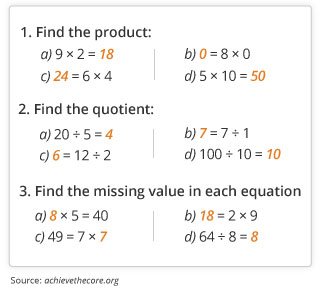
Multiplication is a shortcut for adding up groups with equal numbers of items in them. Division is the opposite: it means dividing a whole into equal parts. Students will be expected to solve problems that show they understand the concept behind division and multiplication.
Sample problem 2: Understanding division
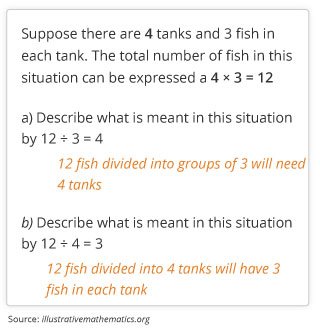
Third graders need to be able to read a word problem, determine which operation to use (+, -, x, ÷), write an equation, and calculate the answer. Questions like the sample problem below ask your child to write equations and/or draw visuals to show their thinking. These visuals and equations help parents and teachers see where a student may have gotten tripped up: reading the question, writing the equation, and/or calculating the answer.
Sample problem 3: Multiplying and dividing to solve problems
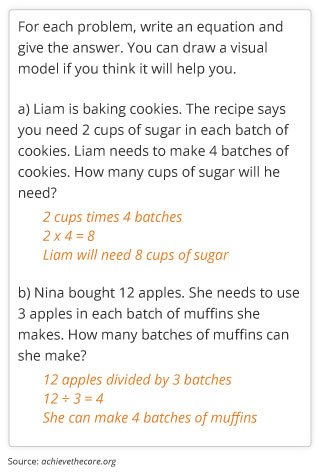
Third graders need to understand the concept of fractions and know that a whole that is divided into 2, 3, 4, 6, or 8 equal pieces makes halves, thirds, quarters, sixths, and eighths.
Sample problem 4: Understanding fractions as a concept
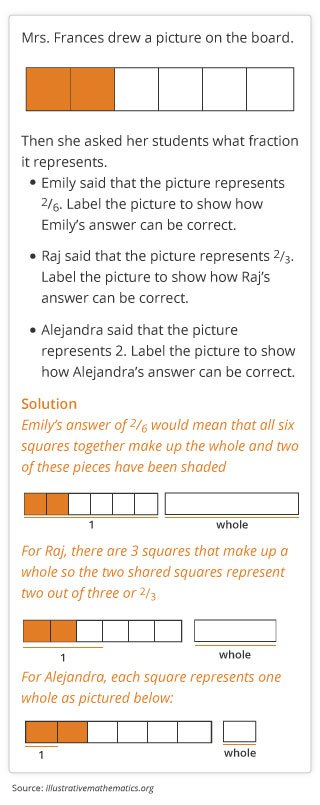
Third graders also need to know that two different fractions can express the same value; these are called equivalent fractions. Your child should be able to produce equivalent fractions, such as 1⁄4 = 2⁄8 and compare different fractions with the same denominator (the bottom number) or the same numerator (the top number).
Sample problem 5: Comparing fractions
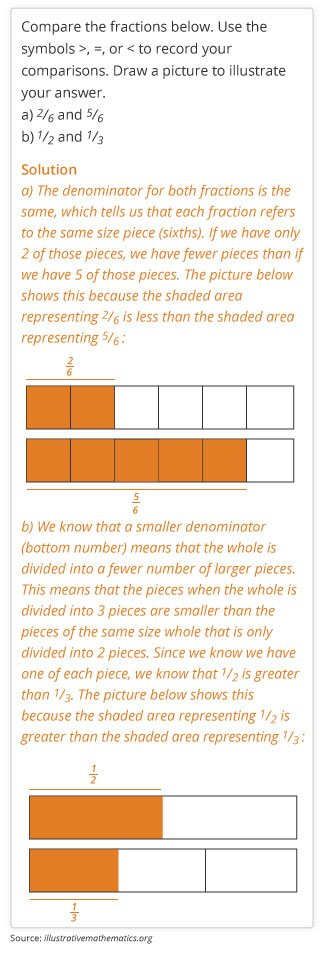
Third graders should be able to draw representations of fractions using shapes and number lines. For example, students should be able to accurately place 1⁄4, 1⁄2, and 3⁄4 on the same number line.
Sample problem 6: Placing fractions on a number line
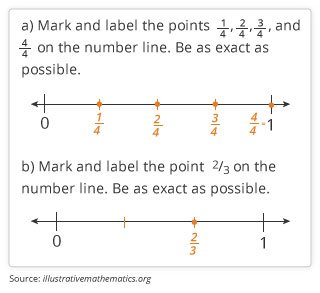
Third graders need to be able to understand — and calculate — both the perimeter and the area of a rectangle. Perimeter is the total length of the outside of the rectangle, so students need to add up the lengths of all four sides. Area is the total space inside the shape, so students need to multiply the shape’s length by its width. At first, students are taught to find area by counting the “blocks” inside of the shape so they can visualize the area they’re calculating. Then, students learn to multiply numbers representing the length and the width to find a rectangle’s area. Finally, students are asked to use what they know about area to find the area of shapes made up of multiple rectangles.
Sample problem 7: Finding the area of a rectangle
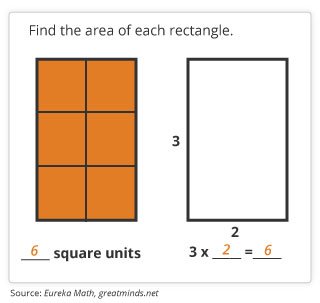
Third graders are asked to solve more complicated area problems that involve more than one rectangle in a figure. Third graders are expected to find the area of each rectangle and then add those areas together. In the sample problem below, the area of the bottom portion is 3 cm x 3 cm = 9 cm2; the area of the top portion of the figure is 2 cm x 5 cm = 10 cm2. Added together, 9 cm2 + 10 cm2 = 19 cm2, which is the total area of the figure. Notice how students need to add the lengths 2 cm + 3 cm to find the 5 cm length of the top portion of the figure. This is common in problems like these.
Sample problem 8: Finding the area of shapes made up of multiple rectangles
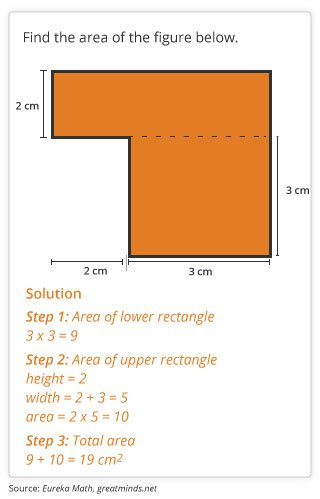
Whether you’re a math whiz or number-phobic, research shows that a parent’s attitude is a big predictor of how well your child will do in math. If you love math, let it show! If you don’t, fake it. Saying things such as “I hate math” — or worse, “I don’t have the math gene” — is contagious. Be the most math-friendly, math-supporting example you can be for your child. It does make a difference.
Make a point of asking the teacher about your child’s math skills. When it comes to concepts (why) and procedures (how), what is your child doing well? What does your child struggle with? Ask the teacher how you can help at home.
This year, your child will face questions that require new problem-solving skills. (Your child’s teacher may call this mathematical thinking.) To tackle these problems, your child needs to first figure out what she’s being asked to find and then whether to add, subtract, multiply, or divide. These problems often involve two steps, such as adding two things together and then using that sum in a division problem. Your child should be able to make sense of a problem and persevere even when the problem is challenging.
Modeling means taking a real-world problem and using math to solve it — with a graph, an equation, a table, or another visual representation. For example, to answer the question If a runner has run two miles of a 10-mile race, how many more miles of the race remain?, a third grader would be expected to draw the scenario, figure out the steps to answer the question, set up the equation, and then solve it.
Data analysis means looking at numbers that represent people, objects, or facts and figuring out what that data tells us. For example, your child may need to look at a table of student enrollment numbers at three different schools and list the schools in order from highest to lowest enrollment.
Third graders need to know how to analyze word problems. Your child should be able to figure out what the problem is asking, which numbers are important, and which of the four operations — multiplication, division, subtraction, or addition (x, ÷, -, +) — to use, and in what order.
Sample problem 1: Analyzing word problems and choosing the right operation
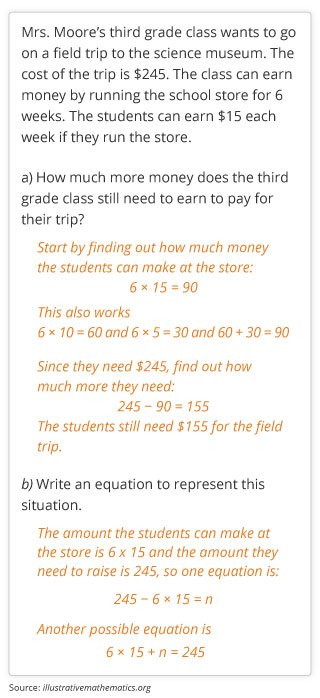
For example, in the sample problem, the question asks how much more money the class will need to pay for their field trip after they’ve run the school store for six weeks. The important numbers here are cost of the field trip: $245, weeks to run the store: 6, and $15 per week for running the store. This problem requires two steps — two equations — to get the answer. First, students must figure out how much the class will earn running the store for 6 weeks: $15/week x 6 weeks = $90 earned (in mathematical notation: 15 x 6 = 90). Second, they need to subtract the amount earned from the total they need: $245 needed – $90 earned = $155 still needed for the trip (in mathematical notation: 245 – 90 = 155).
By the end of third grade, your child should be able to interpret simple charts, graphs, tables, and diagrams. Kids need to use this information to decide how to answer questions and solve problems. Your child should also be able create her own charts and tables based on information contained in a word problem.
Sample problem 2: Analyzing data
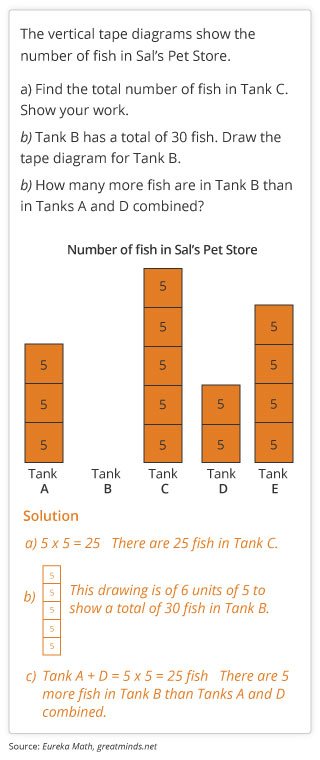
Math can be fun when you find it in the right places. Talk to your child about the math that’s hidden in his hobbies and interests. Sports, cooking, video games, arts and crafts — you can find math in almost any activity if you look for it!
Asking specific questions makes it easier to talk about math. Ask your child’s teacher: What’s an example of a modeling math problem that my child is doing right now? Can you show me? Please share two math problems that test my child’s ability to think through a challenging problem without giving up. Using specific examples can help you and the teacher focus on what your child needs to work on.
Third graders are expected to do more than find the answer. They’re expected to explain how they got the answer and why their solution works. This means your child should be able to describe the steps needed to solve the problem, show her work, and explain why her approach makes sense.
The process of explaining their work shows whether students understand the logic involved in solving a math problem. For example, if a problem asks your child to calculate the height of a five-story building, and each of the stories is 9 feet high, your child should be able to explain why multiplying 5 x 9 to get the building’s height is faster than (but the same as) adding 9 + 9 + 9 + 9 + 9.
In the classroom, third graders are expected to critique their classmates’ reasoning. They need to be able to explain why they agree or disagree. In the sample problem below, students are asked to provide an argument for why they agree or disagree.
Sample problem 1: Critiquing someone else’s answer
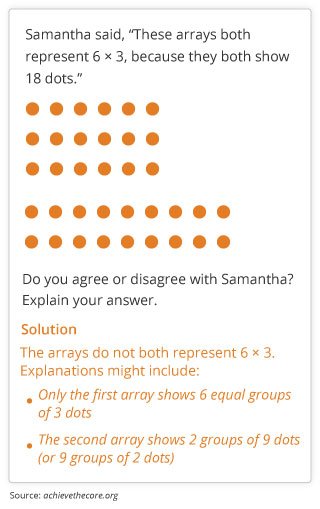
Students may also be asked to explain their answer in writing, as in the sample problem below.
Sample problem 2: Explaining reasoning
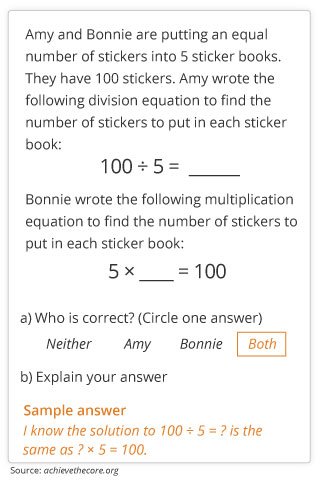
Think of math as a language. Just like we use words to talk about people or places, we use math to communicate about numbers, shapes, measurements, and the relationships between them. And like any language, the more you use it with your child, the more fluent she’ll become!
Ask your child’s teacher how students in the class practice explaining their thinking. Are there any activities you can try at home with your child?
GreatKids created this guide to help you understand your child's state test scores and to support your child's learning all year long. We worked with SBAC and leading teachers in every grade to break down what your child needs to know and exactly how you can help